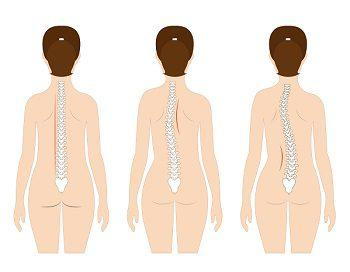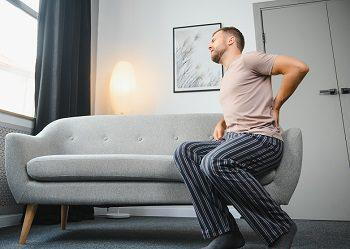What is Scoliosis of the Spine? How Can It be Treated?
- posted: Jan. 31, 2023
People with Scoliosis have a curved spine and lean to one side. The spine typically appears straight when viewed from behind and comprises rectangular-shaped building blocks. These rectangular-shaped building blocks are known as vertebrae and can affect Scoliosis.
Scoliosis is a condition wherein the spine twists and curves to the side. More specifically, it refers to an abnormal lateral curvature of the spine and can affect people of any age. However, it mostly starts in children aged 10 to 15 and continues in their adult lives if not treated. X-rays can detect Scoliosis if the spine curves at an angle of 10 degrees or more. Often referred to as a “spinal deformity,” this condition can affect the thoracic and lumbar regions of the spine.
Scoliosis is a prevalent disorder often identified during the teenage years. Sometimes, the cause of Scoliosis is unknown in patients, or it may develop due to the degeneration of the spinal discs. Whatever the reason, some treatments can stop the curve’s progression and prevent deformity.
Studies show that Scoliosis is more common in girls than boys and affects 2-3 percent of the US population. Recent statistics reveal that 20% of people with spinal deformities in the US live with Scoliosis.
Sometimes, adolescents develop Scoliosis even without any specific reason. However, it’s crucial for you as a parent to know what Scoliosis is and the early signs to look for in growing children. This article will enlighten you on Scoliosis, its symptoms, causes, treatment options, and more. So, let’s get started.
Scoliosis: What You Need to Know?
Scoliosis is a spinal deformity that causes the spine to curve sideways. The curvature can happen in any spinal part; however, it mainly occurs in the upper spine and the lower back. Scoliosis is not always noticeable, but people with Scoliosis mostly lean to one side. They might have unequal hips or shoulders due to the curvature. There are two broad or general categories of Scoliosis, namely;
- Structural and,
- Non-structural scoliosis.
In structural Scoliosis, the spinal rotates in addition to the sideway curvature. These conditions affect the spine’s structural integrity, and typically the research regards this as irreversible unless addressed. Non-structural Scoliosis results from a temporary cause and causes the spine to curve. However, there is no spinal rotation in the non-structural type, so the spinal structure is still considered normal.

Structural Scoliosis is considered more severe than the non-structural type. Here, the scoliosis curve doesn’t go away or straighten on its own, as in the case of non-structural Scoliosis. Consequently, it might cause spinal deformity and requires appropriate treatment. The four most frequent kinds of structural Scoliosis are as follows:
- Degenerative Scoliosis (the joints in the spine degenerate).
- Idiopathic Scoliosis (when Scoliosis happens due to unknown reasons).
- Neuromuscular Scoliosis (people have difficulty walking because of cerebral palsy or neuromuscular condition).
- Congenital Scoliosis (a spinal defect present at birth).
Non-structural Scoliosis, also known as functional Scoliosis, can be reversed with precise movements. The spinal curve in this type of Scoliosis is mainly affected by muscle imbalance, posture factors, disc herniation, or leg length imbalance. However, if the person lies down or bent forward, the scoliosis curve usually goes away when held in that position. The treatment plan would depend on the type and cause of the illness. But it’s always essential to visit the physician if you or your growing child has Scoliosis (structural or non-structural).
Common Signs and Symptoms of Scoliosis
- Unequal shoulders
- Uneven hips
- A visibly curved spine
- The person leans to one side
- Fatigue because of muscle strain
- Numbness or pain in the legs
- Stiffness or lower back pain
Professionals confirm Scoliosis through various physical examinations, such as x-rays, CT (Computerized Tomography) scans, MRI (Magnetic Resonance Imaging), or spinal radiographs. The severity of the deviation from a normal angle help categorizes the malformation.
Causes and Risk Factors of Scoliosis

- Genetic conditions like Down Syndrome
- Infections and tremors
- Cerebral palsy
- Spinal cord abnormalities
- Injury to the spine
- Previous chest surgery as a baby
- Spinal defects present at birth
- Underdevelopment of the spinal bones
- Neuromuscular conditions, etc
Mild Scoliosis generally does not require any treatment at all. However, visiting your physician for a routine checkup is still essential.
Treatment Options for Scoliosis
There are several treatment options for Scoliosis, and your doctor can identify the right one. Patients will Scoliosis are treated by considering their:
- Age; different rules apply to adults and younger children
- The type of Scoliosis they have
- The history of their medical conditions
- The measurement of their back curve
If you or your child has mild Scoliosis, your doctor would recommend a wait-and-see approach. Here, the doctor will closely monitor the backbone curve and analyze whether it improves or worsens with time. If it doesn’t get better, the doctor would recommend other ways of treatment.
Bracing
An orthopedic doctor recommends back bracing if the patient’s curve is between 20-40 degrees. Studies have shown that back bracing is 80% effective in treating young children. However, it doesn’t correct the curve but stops further progression.
There are two types of braces, i.e., plastic and soft. The former is a like a shell that covers the upper body to the pelvis. The latter uses elastic straps and is more comfortable to keep the body intact. You may take it away while you shower or do other activities.
Surgery
Surgical intervention is crucial for treating Neuromuscular Scoliosis. Doctors recommend surgery options when the patient’s curves are between 45 and 50 degrees. These curves can worsen and affect the person’s lungs, too. Spinal fusion surgery is often advised for cases with increasing curves as it halts the advancement of angles in the spine.
Surgery is essential if the patient has a severe form of Scoliosis. However, the patient must have reached spinal maturity to be a qualifying candidate. The basic types of scoliosis surgery include the following:
- Spinal fusion: In this procedure, the doctor combines two or more bones in the spine or vertebrae.
- Expanding rod: If Scoliosis is increasing rapidly in young children, the doctor may attach one or two expandable rods along the spine. The doctor then adjusts the length of these rods once the requirements are known.
- Vertebral body tethering: Doctors suggest small incisions correct Scoliosis. During this surgery, a strong cord is attached to the spine to change its growth.
Chiropractic Treatment
A specialized chiropractor will provide adjustments to cure spinal misalignment. Chiropractors can also treat Scoliosis, provided it’s in a mild form. Chiropractic treatment for Scoliosis aims at realigning joints, bones, and muscles. In doing so, the range of motion is increased throughout the spine to strengthen and stabilize the muscles. Moreover, the chiropractor will recommend a few exercises depending on your symptoms. Some of these include:
- Step down, and one arm reaches
- Upward and downward dog
- Split stance with arm reach
- Schroth exercises (for better posture)
Conclusion
Scoliosis significantly affects individuals’ daily routines and makes their life less enjoyable. It causes visible skeletal deformities and interferes with signals in the nervous system. It also impairs mental health and well-being, from painful muscular imbalances to reduced body circulation. If you have Scoliosis, then why not get rid of it? Today, doctors can treat Scoliosis with careful intervention, which has benefitted many. If you or your child has Scoliosis, visit your physician early. Take a step and feel the difference.
Contact your Scottsdale Chiropractor, Dr. Abbas Khayami, D.C, at Better Health Solutions to learn more about Scoliosis.
Resource:
Chiropractic Care and Scoliosis
*This media/content or any other on this website does not prescribe, recommend, or prevent any treatment or procedure. Therefore, we highly recommend that you get the advice of a qualified dentist or other medical practitioners regarding your specific dental condition*
Better Health Solutions
8040 E Indian School Rd Suite 100,
Scottsdale, AZ 85251
Monday
8:30 am - 6:00 pm
Tuesday
8:30 am - 6:00 pm
Wednesday
8:30 am - 6:00 pm
Thursday
8:30 am - 6:00 pm
Friday
8:30 am - 6:00 pm
Saturday
8:30 am - 2:30 pm
Sunday
Closed
